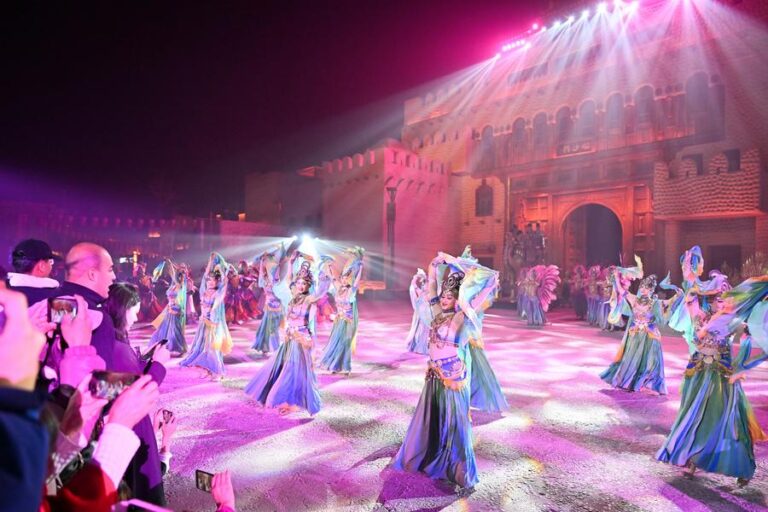URUMQI, July 11 (Xinhua) — As summer draws crowds to Hotan County in northwest China’s Xinjiang Uygur Autonomous Region, Daoxiang Village comes alive with the rich aroma of lamb and corn dishes. Visitors from across China fill its restaurants, homestays and craft shops.
Located on the southern rim of China’s vast Taklimakan Desert, Daoxiang Village, with its name literally meaning Rice Fragrance Village, was once a traditional farming village with a long history of rice cultivation. However, in recent years, it has transformed into a vibrant rural tourist destination.
This notable change is a direct result of China’s long-running “paired assistance” program, under which 18 provincial-level regions and the southern Chinese tech hub of Shenzhen support the development of Xinjiang.
Since 2021, Beijing’s aid projects, including a multi-million yuan investment to establish a “rural complex with folk culture,” have helped upgrade Daoxiang Village’s infrastructure — improving water, electricity, roads and gas.
Renovations of 219 houses, meanwhile, preserved the traditional Uygur Aywan architectural style, a hallmark of local residential design, but also integrated modern comforts in this process.
Early adopters of these upgrades, Gheyret Roziemet and Patime Bak, who are a couple, were inspired after visiting successful rural tourism sites in Kashgar and Ili, also in Xinjiang. Encouraged by local officials and the village support team, they also chose to turn their home into a homestay business.
The couple took out loans to finance the required renovations, keeping the original wooden beams and brick walls while adding bright glass windows, grape arbors and flower beds.
Patime Bak manages the homestay kitchen, roasting lamb and serving mutton soup, while the couple together cultivate corn used to prepare traditional farm-style corn dishes that are proving popular with visitors, thereby boosting their income.
“Now as a boss, I earn several times more monthly than when I worked as a laborer,” Patime Bak said with a smile.
During peak seasons, their courtyard often fills with diners enjoying sunset views across the desert, savoring the rich aroma of roasted lamb amid the rustling of rice stalks.
Today, by leasing their farmland to others and running the homestay, the couple’s annual household income reaches over 200,000 yuan (about 27,982 U.S. dollars). They are planning to renovate an adjacent unused house and use it as an additional guesthouse next year, to welcome even more guests.
Thanks to local rural revitalization policies, committed local officials and continuous funding support from Beijing, more than 1,000 residents in the village now find employment through an “agriculture plus tourism” model, running restaurants, guesthouses and craft shops.
Amyna Gheyret, a local agritainment business owner, said with gratitude: “Thanks to Beijing’s aid, our villagers have work and incomes. My family earns around 5,000 yuan monthly now. With tourism, our wallets keep getting fuller.”
Daoxiang Village’s transformation exemplifies the profound urban-rural changes spurred by China’s paired assistance efforts in Xinjiang.
Launched in 1997 and significantly expanded in 2010, this cross-regional initiative has funneled resources into local development. It has become a cornerstone strategy for boosting prosperity and promoting unity in China’s vast western regions.
This policy provides financial resources, technical expertise and talent from more developed eastern regions to boost Xinjiang’s development.
Beyond Daoxiang Village, similar stories of transformation are unfolding across Xinjiang under the paired assistance program. In Hotan, a textile project supported by Beijing and south China’s Guangdong Province has created over 700 jobs in its first phase alone, empowering locals like Zulaya Tursuntohti with stable employment and technical skills.
Meanwhile, in Aksu, digital empowerment is reshaping rural livelihoods. E-commerce incubators launched with help from the city of Hangzhou in east China, have trained over 9,500 locals in livestreaming and online sales.
Over the past few years, numerous aid projects, ranging from automated planting workshops to textile enterprises and modern cultural tourism sites, have taken root across farming and herding areas, injecting vital momentum into local economic and social development.
“It’s all thanks to good rural revitalization policies, hardworking county officials and the help from aid funds,” said Patime Bak, “That’s how we got the good life we have now.” ■

